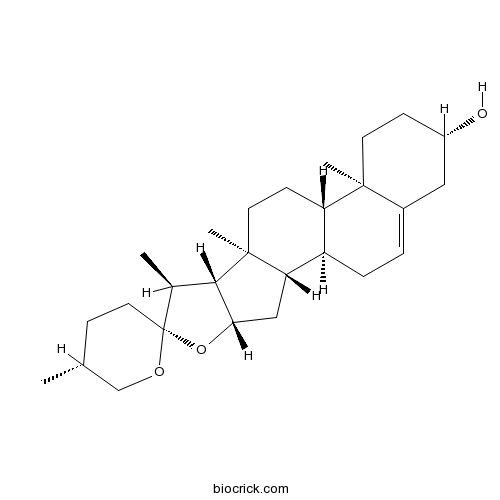Peristrophe bivalvis
Peristrophe bivalvis
1. The products in our compound library are selected from thousands of unique natural products; 2. It has the characteristics of diverse structure, diverse sources and wide coverage of activities; 3. Provide information on the activity of products from major journals, patents and research reports around the world, providing theoretical direction and research basis for further research and screening; 4. Free combination according to the type, source, target and disease of natural product; 5. The compound powder is placed in a covered tube and then discharged into a 10 x 10 cryostat; 6. Transport in ice pack or dry ice pack. Please store it at -20 °C as soon as possible after receiving the product, and use it as soon as possible after opening.
Natural products/compounds from Peristrophe bivalvis
- Cat.No. Product Name CAS Number COA
-
BCN6272
Diosgenin512-04-9
Instructions

Biological activities of Peristrophe bivalvis extracts: promising potential for anti-snake venoms against Naja kaouthia and Trimeresurus albolabris venoms.[Pubmed: 25942501]
This study evaluates the in vitro anti-snake venom potential of Peristrophe bivalvis (PB) extracts against Naja kaouthia (NK) and Trimeresurus albolabris (TA) venoms, including inhibition of cytotoxic effects and enzymatic activities, and the binding-precipitation of extracts and venom proteins analysis. In addition, the antioxidant, cytotoxic and in vivo acute oral toxic activities of PB extracts are also reported. The in vitro cytotoxic and enzymatic analysis reveals that the ethanol extracts of stems and leaves of PB showed good anti-snake venom activity against NK and TA venoms. In addition, the antioxidant result indicated that only the ethanol extract of leaves exhibited weak DPPH radical-scavenging activity. The ethanol whole-plant extract of PB also showed no cytotoxicity against four cell lines. Moreover, the in vivo acute oral toxicity result of the ethanol whole-plant extract showed that all treated rats did not exhibit abnormal toxic signs or deaths.
Isolation, characterisation and biological evaluation of a phenoxazine, a natural dyestuff isolated from leaves of Peristrophe bivalvis.[Pubmed: 22712581]
Peristrophe bivalvis (L.) Merr. (Acanthaceae) is a wild growing and cultivated plant used for dyeing of foods by the ethnic minorities of Vietnam. The major component of the colour aqueous extract (CAE) of its leaves was identified as peristrophine by spectral analysis, especially the 2D NMR spectra (HSQC, HMBC and NOESY). Considering the widespread utilisation of the decoction of this plant for food dyeing, we evaluated the acute oral toxicity of the CAE. Based on the results in an acute toxicity study in mice, the LD50 value of the CAE was determined as 9100 ± 290 mg kg(-1) body weight. Additionally, in vitro cytotoxic assay showed an inhibition of peristrophine against Hepatocellular carcinoma (HepG2, IC503.90 µg mL(-1)). CAE and peristrophine (1) have also been tested for their ability to affect the cell number of the OCI acute myeloid leukaemia cell line. CAE and peristrophine significantly decreased the OCI cell number at different concentrations and times of treatment.


